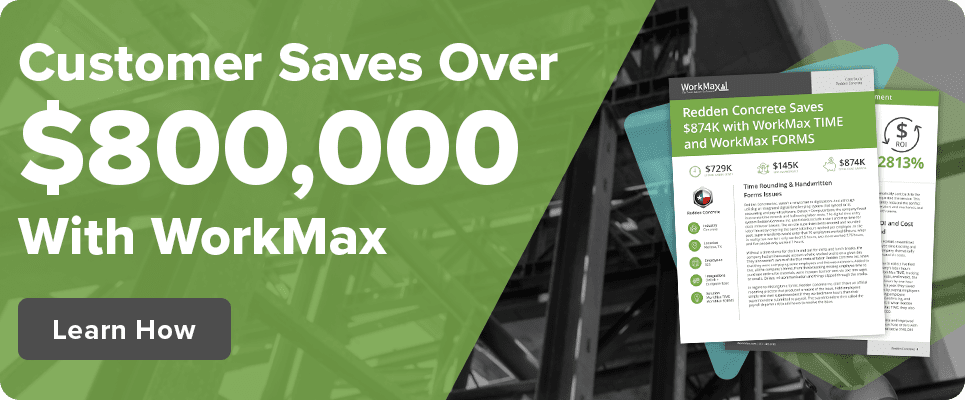Our users reported over 96% customer satisfaction for the last 10 years. Schedule a personal tour of our software to see how we can improve your business’s productivity.
Table of Contents
Share Article
Tracking wages across multiple locations, crews and trades can be a challenge, but add on construction pay types like piecework, per diem as well as custom labor designations in the field, and things get really complicated.
One of the best ways to simplify construction pay types and ensure workers are paid accurately is through automated time tracking, integrated payroll systems, and real-time labor cost monitoring.
It’s important to note that 49% of employees will look for a new job after experiencing two payroll issues, according to Hubstaff.
Accurate time tracking helps you retain your employees and maintain compliance with labor laws. By leveraging construction time tracking apps — like WorkMax — you can automate construction payroll, track construction pay types and avoid payroll issues.
Key Takeaways
- Tracking construction pay types can be a challenge, but construction time tracking software — like WorkMax — is designed to make it much easier.
- Contractors can use WorkMax to automate time tracking and create custom forms and reports for real-time visibility into labor costs and productivity.
- Contractors can easily assign the correct wage classifications across multiple trades, locations, and custom labor roles.
- You’re able to stay ahead of compliance concerns — like the Davis-Bacon Act — by precisely tracking time, even for multi-trade teams.
- WorkMax integrates with leading accounting software and payroll services to help contractors simplify compliance while easily tracking different construction pay types.
Explaining the Different Construction Pay Types
Modern construction projects require flexible payment structures, including hourly wages, performance-based piecework, and location-specific per diem allowances, to attract skilled workers and maintain project profitability.
These different pay structures exist to address the different needs of construction projects, drive productivity and attract top talent.
Each of them offers benefits, but without the right tracking in place, they can quickly become a financial nightmare, especially if multiple construction pay types are present on a single project.
Piecework
Piecework is a payment model in where construction workers are compensated based on how much work they complete instead of an hourly rate. A few examples include:
- Square footage laid
- Units installed
- Linear feet built
This system is common in trades like roofing, drywall and flooring where productivity can be easily measured in units.
For employers, piecework pay in construction incentivizes speed and efficiency, helping projects move faster and maintain timelines. For workers, it offers the potential to earn higher wages by completing tasks quickly.
However, tracking piecework can be a challenge because of:
- Fluctuating volumes of work
- Project delays
- Employees who work multiple trades across several piecework projects simultaneously
Without having an automated time tracking solution in place, it’s easy for contractors to miscalculate piecework pay on projects because of all the moving parts.
Per Diem
Per diem is a unique pay type that is more of an add-on than a direct wage. Think of it as a daily allowance paid to workers to cover travel-related expenses such as lodging and meals when they’re working away from their usual location.
The main goal of per diem is to simplify additional expense tracking because it gives workers a sort of allowance for job-related expenses, and it’s factored into construction project budgets on the front-end.
However, per diem comes with several challenges like:
- Compliance issues related to how the IRS qualifies non-taxable income and how contractors track this information and classify their workers
- Budget issues because per diem can vary widely depending on the project’s location and the local cost of living
- Opportunities for misuse because receipts aren’t always required because it’s paid as a flat rate
It’s important that contractors have clear policies and tracking methods in place to avoid budget overruns and other compliance issues that erode profit margins.
Custom Labor Types
Custom labor types in construction refer to tailored job classifications used to define and track the specific kinds of work performed on a project to ensure workers are paid accurately. It’s important to note these classifications can even change throughout a workday.
Unlike broad categories like “skilled” or “unskilled” labor, custom labor types include more specialized labor like a demolition contractor, plumber, electrician or carpenter.
Wage rates for each of these labor types can differ greatly based on prevailing wage requirements, project difficulty and location.
When labor classifications shift mid-day or between projects, accurately applying the appropriate wage rate is critical to avoid costly errors.
By using custom labor types, contractors get a more detailed wage breakdown — often based on task complexity, required certifications or project-specific roles.
This granular approach gives contractors the ability to better manage labor costs, allocate resources accurately and maintain clearer billing.
While custom labor types allow for greater adaptability and more precise job costing, they introduce complexity in both payroll and compliance, especially when managing multiple pay rates and classifications for a single worker.
Without automated time tracking, custom labor types can lead to inaccurate reporting, audit failures and profit loss due to inflated labor costs.
How WorkMax Simplifies Construction Pay Types

WorkMax is a leading construction time tracking app that automates payroll calculations, manages multiple pay classifications, and ensures compliance with labor regulations to make tracking construction payment structures much easier.
By leveraging each of these built-in capabilities, contractors can have peace of mind when dealing with multi-trade workforces across several projects.
Time Tracking
Tracking time for each worker across multiple trades can be challenging, but construction time tracking apps — like WorkMax — make it easier.
These solutions can automate time tracking and integrate with payroll systems to ensure the proper construction wage structures are applied and factored in during payroll calculations.
Here are several features WorkMax uses to automate time tracking.
First, contractors can require biometrics — like facial recognition — when workers clock in and out. This minimizes opportunities for time stealing tactics like buddy punching.
Contractors can also set up targeted geofencing around their jobsite so their workers can’t accrue hours when they’re not onsite.
Supervisors can also virtually review and approve employee hours to eliminate disputes and discrepancies.
Custom Forms
WorkMax offers custom digital forms that make capturing real-time data from your jobsites easy. That makes identifying productivity goals from piecework much easier.
Additionally, WorkMax provides custom forms to track per diem and ensure workers are following your company’s per diem policies and procedures.
You can also create daily work log forms to capture information when working with teams who are made up of custom labor types or multiple trades.
This helps you identify who performed the work, what trade they were working as and when, helping you avoid payroll disputes, compliance issues and cost overruns down the line.
Live Project Updates
WorkMax’s custom forms can be used to generate detailed reports in just a few clicks. These reports track a variety of key performance indicators, like daily work logs, to determine productivity in real-time, making tracking piecework much easier.
Additionally, WorkMax gives you the ability to create custom reports to drill down into piecework costs, per diem costs and custom labor costs in real-time.
This allows you to address concerns or areas of improvement before they lead to disputes, compliance concerns or erode your profit margins.
In addition to these powerful features, WorkMax also integrates with other leading software to give you more control over your time tracking and payroll processes.

WorkMax Makes Tracking Construction Pay Types Easy
Tracking unique pay types can be a challenge with diverse workforces. Whether it’s per diem, piecework or custom labor types, having systems in place that offer real-time tracking is crucial to avoiding potential costly errors and compliance issues.
Investing in construction time tracking software — like WorkMax — gives you the tools to automate your time tracking and identify productivity in real-time, making construction pay types, like piecework, much easier to track and calculate.
Additionally, WorkMax’s allows you to see where your employees are working and track how many hours they’ve worked across multiple classifications when dealing with custom labor types.
WorkMax’s integration with leading payroll services gives you the ability to automate time tracking and payroll, eliminating the need for manual data entry or paper timecards. It also helps you avoid compliance issues related to prevailing wage and certified payroll.
By accurately tracking wages for custom roles, per diem workers, and piecework crews, WorkMax supports fair pay practices across the board.
For more information about WorkMax, speak with a specialist today.


